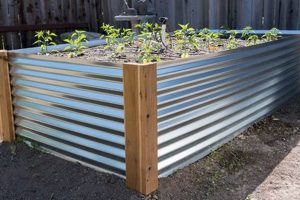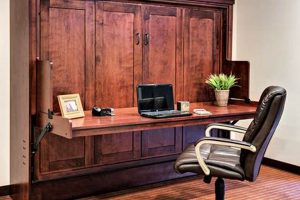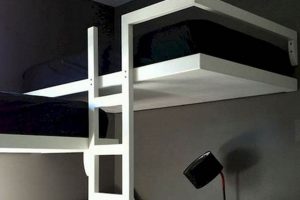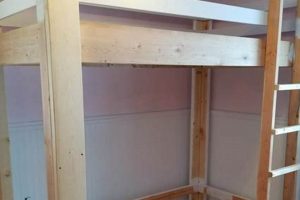The construction of a bed frame featuring four vertical posts, traditionally extending above the mattress to support decorative canopies, is a project undertaken by individuals seeking customized bedroom furniture. This type of self-initiated construction allows for variations in materials, dimensions, and aesthetic details that are tailored to specific preferences and spatial requirements. For instance, a homeowner might choose reclaimed wood to build a frame that complements a rustic dcor scheme, while adhering to the exact dimensions needed to fit a uniquely shaped room.
The practice of creating such furniture offers significant advantages, including cost savings compared to purchasing commercially manufactured items and the ability to personalize the design to match existing interior design elements. Historically, these structures served practical purposes, such as providing warmth and privacy through the addition of heavy curtains. Contemporary motivations extend to creative expression and the satisfaction of mastering a tangible skill, offering a unique piece of furniture with personalized meaning and value.
The subsequent discussion will address key aspects involved in this construction process, encompassing material selection, structural considerations, joinery techniques, and finishing methods. Careful planning and execution are essential for achieving a structurally sound and aesthetically pleasing outcome.
Essential Guidance for Four-Poster Bed Construction
The following recommendations are designed to optimize the structural integrity and aesthetic appeal of a self-constructed bed frame. Adherence to these guidelines will contribute to a durable and visually satisfying outcome.
Tip 1: Prioritize Precise Measurements: Accurate dimensions are paramount. Measure the intended mattress to ensure a snug and secure fit within the constructed frame. Consider accounting for bedding thickness.
Tip 2: Select Appropriate Materials: Wood species should be chosen based on desired aesthetics and load-bearing capacity. Hardwoods, such as oak or maple, provide enhanced durability compared to softwoods like pine. Ensure lumber is properly dried to minimize warping or cracking.
Tip 3: Employ Robust Joinery Techniques: Secure connections are critical for frame stability. Mortise and tenon joints, reinforced with wood glue and screws, offer superior strength compared to simpler butt joints. Consider the load each joint will bear when selecting a technique.
Tip 4: Reinforce Corner Posts: The corner posts are subject to significant stress. Metal brackets, strategically placed, can provide additional support and prevent wobbling. Ensure the brackets are appropriately sized and securely fastened.
Tip 5: Implement a Leveling System: Uneven floors can compromise the bed frame’s stability. Adjustable feet on the bottom of the posts allow for fine-tuning and ensure a level sleeping surface. These can be integrated subtly into the overall design.
Tip 6: Apply a Durable Finish: A protective coating safeguards the wood from moisture and wear. Consider a sealant, stain, and varnish combination. Multiple coats are recommended, with light sanding between each application.
Tip 7: Plan Canopy Attachment Method: If a canopy is intended, integrate attachment points during construction. Recessed hardware or pre-drilled holes will facilitate the secure and aesthetically pleasing attachment of fabric or other canopy materials.
By implementing these recommendations, individuals can significantly increase the likelihood of constructing a structurally sound and visually appealing bed frame. Attention to detail throughout the process is essential for a successful outcome.
The subsequent section will delve into potential challenges and troubleshooting techniques encountered during construction, offering solutions for common issues that may arise.
1. Precise Measurement
In the context of self-constructing a bed frame with four vertical posts, accuracy in dimensional planning is not merely advisable but fundamentally essential. The structural integrity, aesthetic harmony, and functional usability of the final product depend heavily on the precision with which measurements are taken and implemented.
- Mattress Accommodation
The primary function of the frame is to securely house the mattress. Inaccurate measurements risk either a mattress that is too large, leading to overhang and instability, or one that is too small, resulting in unsightly gaps and potential movement. Precise internal dimensions, factoring in any anticipated bedding, ensure a snug and aesthetically pleasing fit.
- Post Height Uniformity
The vertical posts serve as the foundational support for the entire structure. Variances in post height, even minor ones, can lead to an uneven sleeping surface, compromising comfort and potentially stressing joints. Careful measurement and cutting of each post to an identical height is therefore critical.
- Rail Length and Alignment
The rails, connecting the posts, dictate the overall length and width of the bed frame. Inaccurate rail lengths can result in a skewed or trapezoidal structure, impacting stability and visual appeal. Precise measurements and careful alignment during assembly are essential to create a rectangular frame.
- Canopy Compatibility
If the intended design incorporates a canopy, the dimensions of the posts and connecting upper frame elements must be meticulously planned. Inaccurate measurements can lead to a canopy that is either too small, failing to provide adequate coverage, or too large, resulting in unsightly sagging and potential interference with surrounding fixtures.
These facets collectively highlight the indispensable role of accurate measurement in the successful construction of a bed frame with four vertical posts. Neglecting this foundational step can lead to a range of functional and aesthetic deficiencies, underscoring the need for meticulous planning and execution from the outset.
2. Wood Selection
The choice of wood fundamentally determines the structural integrity, longevity, and aesthetic character of a self-constructed bed frame with four vertical posts. The selected wood directly influences the frame’s ability to withstand weight, resist warping or cracking, and maintain its visual appeal over time. Failure to consider these factors during material selection can result in a bed frame that is structurally unsound, aesthetically displeasing, or both. For example, using a softwood such as pine for a king-sized bed without adequate reinforcement may lead to sagging or joint failure under the weight of the mattress and occupants. Conversely, a hardwood like cherry, while aesthetically desirable, may be excessively costly for some project budgets, necessitating a compromise with a less expensive, yet structurally adequate, alternative.
Different wood species possess varying properties that are relevant to bed frame construction. Hardwoods, generally denser and stronger than softwoods, provide superior load-bearing capacity and resistance to wear. Oak, maple, and ash are commonly employed for their strength and durability, making them suitable for the main structural components such as the posts and rails. Softwoods, such as pine or fir, may be used for less critical elements or decorative features, provided they are adequately reinforced. The moisture content of the wood is also a crucial consideration. Kiln-dried lumber minimizes the risk of warping or shrinking after construction, ensuring that the frame remains stable and true to its original dimensions. The grain pattern and color of the wood contribute significantly to the bed frame’s aesthetic appeal, influencing the overall style and complementing existing bedroom decor. For instance, a rustic design might favor reclaimed wood with visible knots and imperfections, while a more modern aesthetic may call for a smooth, uniform-grained hardwood.
In summary, wood selection is a critical decision point in the design and construction of a four-poster bed. Structural requirements, aesthetic preferences, and budgetary constraints must be carefully balanced to ensure a successful outcome. Careful consideration of wood species, moisture content, and grain pattern will result in a bed frame that is not only functional and durable but also a visually pleasing addition to the bedroom. Overlooking these factors significantly increases the risk of structural failure, aesthetic disappointment, or premature deterioration.
3. Joinery Strength
The structural integrity of a bed frame with four vertical posts hinges directly on the strength and quality of its joinery. Joinery, the methods used to connect individual wooden components, dictates the frame’s ability to withstand weight, resist racking forces, and maintain its form over prolonged use. Inadequate joinery will inevitably lead to instability, premature failure, and compromised safety. For instance, a bed frame utilizing simple butt joints held together solely by screws may initially appear functional but will quickly degrade under repeated stress, resulting in wobbly posts, sagging rails, and a reduced lifespan. Conversely, employing robust joinery techniques, such as mortise and tenon joints reinforced with glue and fasteners, distributes stress more evenly and provides significantly greater resistance to deformation and failure.
The specific joinery methods employed should be carefully selected based on the anticipated load and the characteristics of the wood being used. Mortise and tenon joints, known for their strength and reliability, are well-suited for connecting the posts to the rails, where significant stress is concentrated. Dovetail joints, while aesthetically pleasing, may be more appropriate for drawers or decorative elements rather than primary structural connections. Pocket hole joinery, a faster and simpler alternative, may be acceptable for secondary components or when augmented with additional reinforcement, but is generally not recommended for critical load-bearing joints. The choice of fasteners, such as screws or bolts, is also crucial. Screws should be of adequate length and gauge to provide sufficient holding power, while bolts should be properly sized and tightened to ensure a secure connection. Glue, when used in conjunction with mechanical fasteners, enhances the strength and rigidity of the joint by filling gaps and providing additional bonding surface.
In conclusion, joinery strength is not merely a desirable attribute but a fundamental requirement for a stable and durable bed frame. Careful consideration of the anticipated loads, the properties of the selected wood, and the appropriate joinery techniques is essential for a successful project. Neglecting this aspect will inevitably lead to structural weaknesses, compromising the bed frame’s functionality and potentially posing a safety hazard. Therefore, investing time and effort in mastering robust joinery techniques is a critical investment in the long-term quality and reliability of a self-constructed bed with four vertical posts.
4. Post Reinforcement
Post reinforcement is a critical aspect of self-constructing a bed frame featuring four vertical posts, directly influencing the structure’s stability and load-bearing capacity. The primary cause of structural failure in such beds often stems from inadequate post support, leading to wobbling, leaning, or even complete collapse under the combined weight of the mattress and occupants. Therefore, appropriate reinforcement is not merely an optional addition but a fundamental requirement for ensuring a safe and durable finished product. For example, a queen-sized bed constructed with slender, unreinforced posts is highly susceptible to lateral movement and eventual failure, particularly if subjected to dynamic loads such as those generated by movement during sleep.
Several methods can be employed to enhance post strength. Internal reinforcement, such as inserting metal rods or wooden dowels within the post’s core, provides additional resistance to bending forces. External reinforcement involves attaching metal brackets or wooden bracing to the post’s exterior, distributing the load and preventing deformation. The choice of reinforcement method depends on the post’s dimensions, the intended load, and the desired aesthetic. For instance, a rustic design might incorporate visible wooden bracing, while a more contemporary style might opt for concealed metal reinforcement. Proper selection and implementation of these techniques can significantly extend the lifespan of the bed frame and enhance its overall structural integrity. Consider the case of a family building a bed frame for their growing teenager. By reinforcing the posts with sturdy metal brackets, they ensure the bed can withstand the increased weight and activity level, providing a safe and reliable sleeping platform for years to come.
In summary, post reinforcement is an indispensable component of constructing a bed frame with four vertical posts, mitigating the risk of structural failure and ensuring long-term stability. The selection of appropriate reinforcement methods and materials requires careful consideration of the intended load, the post’s dimensions, and the desired aesthetic. While challenges may arise in seamlessly integrating reinforcement elements into the overall design, the benefits of enhanced structural integrity far outweigh the added complexity. By prioritizing post reinforcement, individuals undertaking such construction can create a bed frame that is not only visually appealing but also safe, durable, and capable of providing reliable support for years to come.
5. Finishing Durability
The application of a durable finish to a self-constructed bed frame with four vertical posts is paramount for protecting the wood, enhancing its aesthetic appeal, and prolonging the lifespan of the furniture. A well-executed finish acts as a barrier against moisture, scratches, and UV damage, preventing degradation and maintaining the bed frame’s integrity over time.
- Moisture Resistance
Wood is susceptible to moisture absorption, leading to warping, swelling, and the growth of mold or mildew. A durable finish seals the wood’s surface, preventing moisture penetration and preserving its structural stability. For instance, a polyurethane finish provides a robust, water-resistant barrier ideal for humid environments, minimizing the risk of damage and extending the bed frame’s lifespan. Without such protection, a bed frame in a humid climate may exhibit signs of deterioration within a relatively short period.
- Scratch and Abrasion Protection
Daily use subjects the bed frame to potential scratches and abrasions from bedding, clothing, and accidental impacts. A durable finish provides a protective layer that resists these damages, preserving the wood’s surface appearance. For example, a varnish finish, known for its hardness and resistance to scratching, can safeguard the bed frame from everyday wear and tear, maintaining its aesthetic appeal for years. Neglecting this aspect could result in a bed frame that quickly loses its visual appeal due to surface imperfections.
- UV Light Resistance
Exposure to ultraviolet (UV) light can cause wood finishes to fade, discolor, or even break down over time. A finish with UV inhibitors helps to protect the wood from these harmful effects, preserving its original color and preventing premature degradation. For instance, a spar varnish, designed for marine applications, provides excellent UV protection, making it suitable for bed frames placed near windows. Without adequate UV protection, a bed frame exposed to direct sunlight may exhibit significant color changes and finish deterioration over time.
- Ease of Maintenance
A durable finish simplifies cleaning and maintenance, making it easier to remove dust, dirt, and spills without damaging the underlying wood. A smooth, non-porous finish allows for easy wiping and prevents the absorption of stains. For example, a lacquer finish, known for its smooth and glossy surface, facilitates effortless cleaning and maintenance, ensuring the bed frame remains visually appealing with minimal effort. A poorly protected surface, on the other hand, may require specialized cleaning products or frequent refinishing to maintain its appearance.
These considerations underscore the importance of selecting and applying a durable finish to a self-constructed bed frame with four vertical posts. By providing protection against moisture, scratches, UV light, and facilitating ease of maintenance, a well-chosen finish significantly enhances the bed frame’s longevity, aesthetic appeal, and overall value. Overlooking this aspect can result in a bed frame that deteriorates rapidly, requiring costly repairs or replacement. Therefore, careful attention to finishing durability is an essential investment in the long-term quality of the furniture.
Frequently Asked Questions
The following addresses common inquiries regarding the self-construction of a bed frame featuring four vertical posts. These responses aim to provide clarity and guidance based on accepted woodworking practices.
Question 1: What is the minimum recommended wood thickness for the bed frame posts?
The minimum recommended wood thickness for bed frame posts is 3.5 inches (8.9 cm) for smaller bed sizes (twin, full) and 4.5 inches (11.4 cm) for larger sizes (queen, king, California king). These dimensions provide adequate structural support under typical load conditions. The specific wood species selected will also influence the required thickness.
Question 2: Is it necessary to use metal hardware to reinforce the joints?
While not strictly mandatory, the incorporation of metal hardware, such as corner brackets or bed bolts, significantly enhances joint strength and overall frame stability. This is particularly advisable for larger bed sizes or when using softer wood species. Hardware should be selected based on load-bearing capacity and compatibility with the chosen joinery techniques.
Question 3: How should the bed frame be attached to the headboard or footboard?
Headboards and footboards can be attached to the bed frame using a variety of methods, including mortise and tenon joints, metal brackets, or bed bolt systems. The chosen method should provide a secure and stable connection, preventing movement or separation between the frame and the attached components. Ensure that the attachment method is compatible with the design and construction of both the frame and the headboard/footboard.
Question 4: What type of finish is most resistant to wear and tear?
Polyurethane finishes are widely recognized for their durability and resistance to wear and tear. These finishes provide a hard, protective coating that withstands scratches, abrasions, and moisture. Multiple coats of polyurethane are recommended, with light sanding between each coat to ensure a smooth and even surface.
Question 5: How can the bed frame be leveled on an uneven floor?
Leveling feet, adjustable glides, or shims can be used to compensate for uneven floors. Adjustable leveling feet allow for precise height adjustments, ensuring that the bed frame sits level and stable. Shims, thin pieces of wood or plastic, can be placed under the bed frame posts to achieve a level surface. Ensure that the weight is evenly distributed across all posts after leveling.
Question 6: What are the safety considerations during construction?
Safety is paramount during all phases of construction. Wear appropriate personal protective equipment, including safety glasses, hearing protection, and a dust mask. Use power tools according to manufacturer instructions and ensure that all tools are in good working order. Work in a well-ventilated area and dispose of waste materials properly.
In summary, diligent planning, careful execution, and adherence to safety guidelines are essential for successful construction. By addressing these common questions, individuals can mitigate potential challenges and achieve a structurally sound and aesthetically pleasing outcome.
The subsequent discussion will address potential challenges and troubleshooting techniques encountered during construction, offering solutions for common issues that may arise.
Conclusion
The preceding discourse has examined crucial aspects associated with the construction of a bed frame featuring four vertical posts. Key considerations, including precise measurement, appropriate wood selection, robust joinery techniques, effective post reinforcement, and durable finishing methods, have been delineated. A comprehensive understanding of these elements is essential for achieving a structurally sound and aesthetically pleasing outcome.
The endeavor requires meticulous planning and skillful execution. The information presented serves as a guide for individuals undertaking such a project. Diligence in applying these principles will contribute to the creation of a durable and personalized piece of furniture. Subsequent projects may benefit from ongoing research and adaptation to evolving construction techniques.



![DIY Truck Bed Rack: Build Your Own Bed Rack [Plans] The DIY Hub: Creative Crafts, Repairs & Life Hacks DIY Truck Bed Rack: Build Your Own Bed Rack [Plans] | The DIY Hub: Creative Crafts, Repairs & Life Hacks](https://craftingdiycenter.com/wp-content/uploads/2025/07/th-2452-300x200.jpg)



